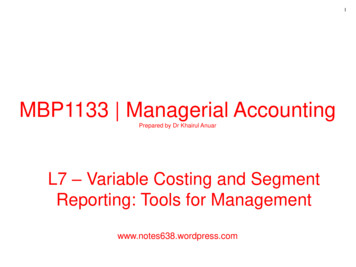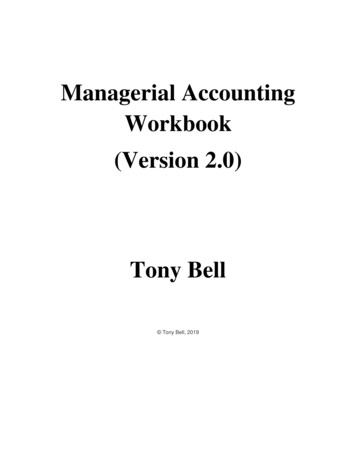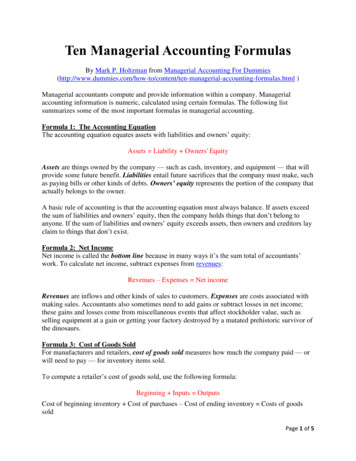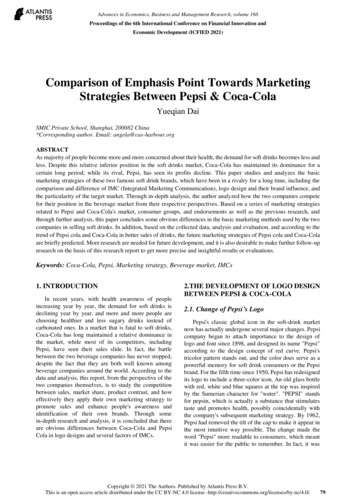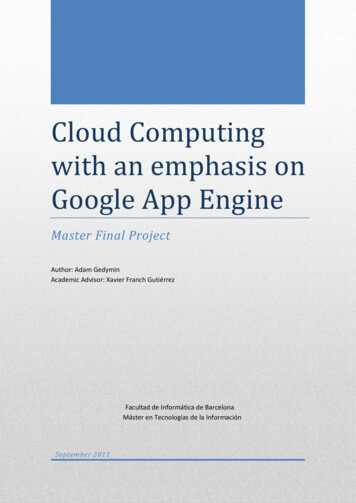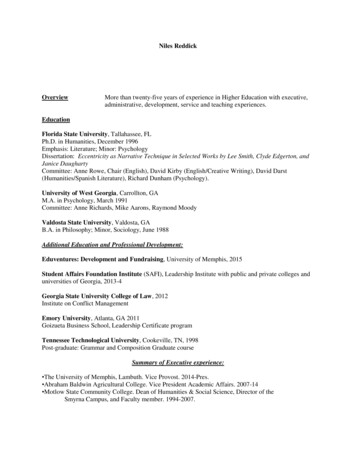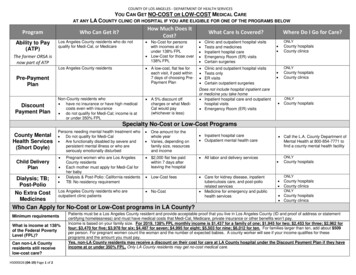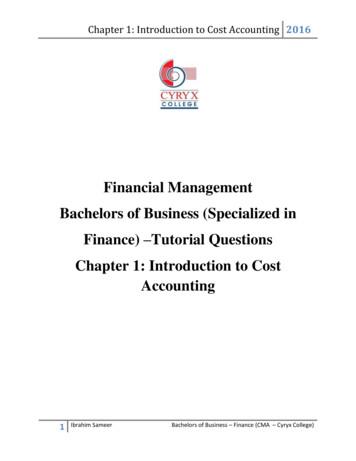
Transcription
EACost Accounting: A Managerial Emphasis, 16e, Global Edition (Horngren)Chapter 1 The Manager and Management Accounting1.1 Objective 1.11) Management accounting .A) focuses on estimating future revenues, costs, and other measures to forecast activities and their resultsB) provides information about the company as a wholeC) reports information that has occurred in the past that is verifiable and reliableD) provides information that is generally available only on a quarterly or annual basisAnswer: AExplanation: Management accounting has a forward-looking orientation as opposed to financialaccounting which has a historical perspective.Diff: 1Objective: 1AACSB: Analytical thinking2) Managers use management accounting information to .A) help external users such as investors, banks, regulators, and suppliersB) communicate, develop, and implement strategiesC) communicate a firm's financial position to investors, banks, regulators, and other outside partiesD) ensure that financial statements are consistent with the SEC rulesAnswer: BDiff: 1Objective: 1AACSB: Analytical thinking3) Financial accounting .A) focuses on the future and includes activities such as preparing next year's operating budgetB) must comply with GAAP (generally accepted accounting principles)C) is the process of measuring, analyzing, and reporting financial and nonfinancial information related tothe costs of acquiring or using resources in an organizationD) is prepared for the use of department heads and other employeesAnswer: BDiff: 1Objective: 1AACSB: Analytical thinking4) Which of the following would most likely be the user of financial accounting information?A) factory shift supervisorB) distribution managerC) current shareholderD) department managerAnswer: CDiff: 1Objective: 1AACSB: Analytical thinking1Copyright 2018 Pearson Education, Ltd.
EA5) The primary user of management accounting information is a(n) .A) the controllerB) a shareholder evaluating a stock investmentC) bondholderD) external regulatorAnswer: ADiff: 1Objective: 1AACSB: Analytical thinking6) Financial accounting provides the primary source of information for .A) decision making in the assembly and finishing departmentB) improving distribution and customer serviceC) preparing the income statement for shareholders and other external partiesD) planning next year's plans and specifically; the operating budgetAnswer: CDiff: 1Objective: 1AACSB: Analytical thinking7) Which of the following is true of management accounting information?A) It focuses on documenting past business actions of a firm.B) It is prepared based on SEC rules and FASB accounting principles.C) It is prepared for shareholders.D) It helps with the coordination of elements of the value chain.Answer: DDiff: 2Objective: 1AACSB: Analytical thinking8) Which of the following statements refers to management accounting information?A) There are no regulations governing the reports.B) The reports are generally delayed and historical.C) The audience tends to be stockholders, creditors, and tax authorities.D) It primarily measures manager's compensation on reported financial results.Answer: ADiff: 2Objective: 1AACSB: Analytical thinking9) Which of the following groups would be least likely to receive detailed management accountingreports?A) stockholdersB) sales managersC) production supervisorsD) distribution managersAnswer: ADiff: 1Objective: 1AACSB: Analytical thinking2Copyright 2018 Pearson Education, Ltd.
EA10) Management accounting information typically includes .A) tabulated results of customer satisfaction surveysB) the cost of producing a productC) the percentage of units produced that are defectiveD) All of these answers are correct.Answer: DDiff: 1Objective: 1AACSB: Application of knowledge11) Cost accounting .A) measures the costs of acquiring or using resources in an organizationB) measures the financial and nonfinancial information that helps managers make decisions to fulfill thegoals of an organizationC) coordinates product design, production, and marketing decisions and evaluate a company'sperformanceD) communicates information to investors, banks, regulators, and other outside partiesAnswer: ADiff: 1Objective: 1AACSB: Analytical thinking12) Which of the following differentiates cost accounting and financial accounting?A) The primary users of cost accounting are the investors, whereas the primary users of financialaccounting are the managers.B) Cost accounting deals with product design, production, and marketing strategies, whereas financialaccounting deals mainly with pricing of the products.C) Cost accounting measures only the financial information related to the costs of acquiring fixed assetsin an organization, whereas financial accounting measures financial and nonfinancial information of acompany's business transactions.D) Cost accounting measures information related to the costs of acquiring or using resources in anorganization, whereas financial accounting measures a financial position of a company to investors,banks, and external parties.Answer: DDiff: 2Objective: 1AACSB: Analytical thinking13) Which of the following is true of financial accounting information?A) It is prepared based on cost-benefit analysis.B) It is primarily used by managers to make internal business decisions.C) It focuses on the past-oriented financial performance of a company.D) It only measures the cash transactions of a company.Answer: CDiff: 2Objective: 1AACSB: Analytical thinking3Copyright 2018 Pearson Education, Ltd.
EA14) A data warehouse or infobarn .A) is reserved for exclusive use by the CFOB) is primarily used for financial reporting purposesC) stores information used by different managers for multiple purposesD) gathers only nonfinancial informationAnswer: CDiff: 1Objective: 1AACSB: Analytical thinking15) Which of the following is true of cost accounting?A) It is a subset of management accounting and therefore its information is used only to meet the needs ofmanagers.B) It is used only by manufacturers.C) It is part of both management and financial accounting systems.D) The distinction between management accounting and cost accounting is clear-cut.Answer: CDiff: 2Objective: 1AACSB: Analytical thinking16) Which of the following deals with management accounting?A) identifying the costs of acquiring the resources of the companyB) developing budgetsC) preparing the income statementD) preparing the statement of cash flowsAnswer: BDiff: 1Objective: 1AACSB: Analytical thinking17) Financial accounting is concerned primarily with .A) external reporting to investors, creditors, and government authoritiesB) cost planning and cost controlsC) product design and marketing strategiesD) providing information for strategic and tactical decisionsAnswer: ADiff: 1Objective: 1AACSB: Analytical thinking4Copyright 2018 Pearson Education, Ltd.
EA18) Financial accounting provides a historical perspective, whereas management accounting emphasizes.A) the futureB) past transactionsC) a current perspectiveD) reports to shareholdersAnswer: ADiff: 1Objective: 1AACSB: Analytical thinking19) Rules for measurement and reporting for management accounting .A) state that information must only be useful to management.B) do not need to follow GAAP but must meet the cost-benefit test.C) must follow GAAP.D) must follow GAAP, IRS rules or government standards.Answer: BDiff: 2Objective: 1AACSB: Analytical thinking20) The approaches and activities of managers in short-run and long-run planning and control decisionsthat increase value for customers and lower costs of products and services are known as .A) value chain managementB) enterprise resource planningC) cost managementD) customer value managementAnswer: CDiff: 1Objective: 1AACSB: Analytical thinking21) Financial accounting information focuses on internal reporting.Answer: FALSEExplanation: Management accounting information focuses on internal reporting and financial accountingfocuses on external reporting.Diff: 1Objective: 1AACSB: Analytical thinking22) Cost accounting provides information for both management accounting and financial accountingprofessionals.Answer: TRUEDiff: 2Objective: 1AACSB: Analytical thinking5Copyright 2018 Pearson Education, Ltd.
EA23) Management accounting information and reports do not have to follow set principles or rules such asGAAP but should be useful to its audience and meet the cost/benefit test.Answer: TRUEDiff: 1Objective: 1AACSB: Analytical thinking24) Management accounting ensures communication of an organization's financial position to investors,banks, and regulators.Answer: FALSEExplanation: Financial accounting, not management accounting, ensures communication of anorganization's financial position to investors, banks, and regulators.Diff: 1Objective: 1AACSB: Analytical thinking25) The balance sheet and income statement are primarily management accounting reports.Answer: FALSEExplanation: The balance sheet and income statement are primarily financial accounting reportsproduced for owners, investors, and other external parties that provide capital or regulate the business.Diff: 1Objective: 1AACSB: Analytical thinking26) Financial accounting is broader in scope than management accounting in that financial accounting caninclude external reporting and reporting that helps managers plan and control operations.Answer: FALSEExplanation: Management accounting is broader in scope than financial accounting as it can encompasssome GAAP issues such as inventory valuation and cost of goods sold and it also provides reporting tohelp managers make decisions and plan and control operations.Diff: 1Objective: 1AACSB: Analytical thinking27) Cost accounting measures and reports short-term, long-term, financial, and non financial information.Answer: TRUEDiff: 2Objective: 1AACSB: Analytical thinking28) Cost accounting is the process of measuring, analyzing, and reporting financial and nonfinancialinformation related to the costs of acquiring or using resources in an organization.Answer: TRUEDiff: 1Objective: 1AACSB: Analytical thinking6Copyright 2018 Pearson Education, Ltd.
EA29) Management accounting has to strictly follow the rules of generally accepted accounting principlesfor the purposes of measurement and reporting.Answer: FALSEExplanation: Internal measures and reports do not have to follow GAAP. Usefulness and the cost/benefitapproach are the guiding principles of management accounting.Diff: 2Objective: 1AACSB: Analytical thinking30) For management accounting, internal measurement and reporting are based on cost-benefit analysis.Answer: TRUEDiff: 2Objective: 1AACSB: Analytical thinking31) Management accounting report time spans can vary from one hour to many years, while financialaccounting report time periods usually span a quarter or a year.Answer: TRUEDiff: 1Objective: 1AACSB: Analytical thinking32) Financial accounting provides an organization's past-oriented information such as the previous years'financial statements.Answer: TRUEExplanation: Financial accounting provides an organization's past-oriented information such as theprevious years' financial statements.Diff: 1Objective: 1AACSB: Analytical thinking33) Cost management not only helps reduce costs but also improve customer satisfaction and the qualityof a firm's products.Answer: TRUEDiff: 1Objective: 1AACSB: Analytical thinking7Copyright 2018 Pearson Education, Ltd.
EA34) For each report listed below, identify whether the major purpose of the report is for (1) routineinternal reporting, (2) nonroutine internal reporting, or for (3) external reporting to investors and otheroutside parties.Item:a. study detailing sale information of the top-ten selling productsb. weekly report of total sales generated by each store in the metropolitan areac. annual Report sent to shareholdersd. monthly report comparing budgeted sales by store to actual salesAnswer:a. (2) nonroutine internal reportingb. (1) routine internal reportingc. (3) external reporting to investors and other outside partiesd. (1) routine internal reportingDiff: 3Objective: 1AACSB: Application of knowledge35) Describe management accounting and financial accounting.Answer: Management accounting provides information to internal decision makers of the business suchas top executives, managers, sales representatives, and production supervisors. Its purpose is to helpmanagers predict and evaluate future results. Reports are generated often and usually broken down intosmaller reporting divisions such as department or product line. There are no rules to be complied withsince these reports are for internal use only. Management accounting embraces more extensively suchtopics as the development and implementation of strategies and policies, budgeting, special studies andforecasts, influence on employee behavior, and nonfinancial as well as financial information.Financial accounting, by contrast, provides information to external decision makers such as investors andcreditors. Its purpose is to present a fair picture of the financial condition of the company. Reports aregenerated quarterly or annually and report on the company as a whole. The financial statements mustcomply with GAAP (generally accepted accounting principles). A CPA audits, or verifies, that GAAP isbeing followed.Diff: 3Objective: 1AACSB: Analytical thinking36) Cost accounting provides information for both management accounting and financial accountingprofessionals. Explain.Answer: Cost accounting is the process of measuring, analyzing, and reporting financial andnonfinancial information related to the costs of acquiring or using resources in an organization. Forexample, calculating the cost of a product is a cost accounting function that meets both the financialaccountant's inventory-valuation needs and the management accountant's decision-making needs such asdeciding how to price products and choosing w
A) The primary users of cost accounting are the investors, whereas the primary users of financial accounting are the managers. B) Cost accounting deals with product design, production, and marketing strategies, whereas financial accounting deals mainly with pricing of the products. C) Cost accounting measures only the financial information related to the costs of acquiring fixed assets
